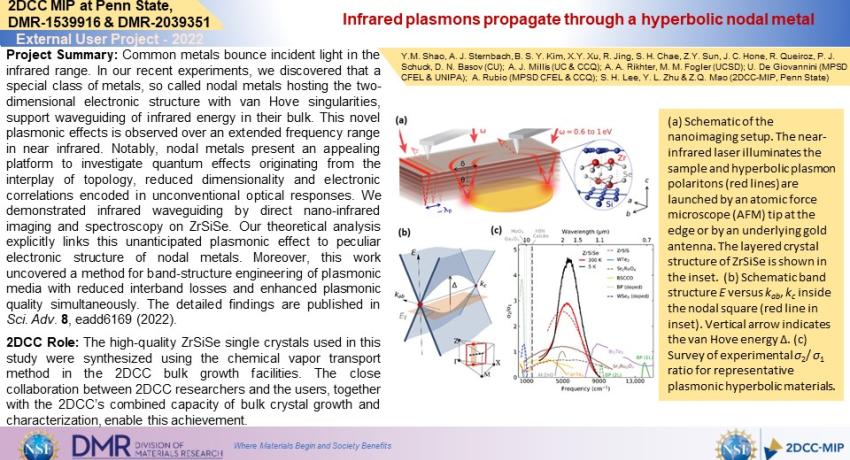Project Summary: Common metals bounce incident light in the infrared range. In our recent experiments, we discovered that a special class of metals, so called nodal metals hosting the two-dimensional electronic structure with van Hove singularities, support waveguiding of infrared energy in their bulk. This novel plasmonic effects is observed over an extended frequency range in near infrared. Notably, nodal metals present an appealing platform to investigate quantum effects originating from the interplay of topology, reduced dimensionality and electronic correlations encoded in unconventional optical responses. We demonstrated infrared waveguiding by direct nano-infrared imaging and spectroscopy on ZrSiSe. Our theoretical analysis explicitly links this unanticipated plasmonic effect to peculiar electronic structure of nodal metals. Moreover, this work uncovered a method for band-structure engineering of plasmonic media with reduced interband losses and enhanced plasmonic quality simultaneously. The detailed findings are published in Sci. Adv. 8, eadd6169 (2022).
2DCC Role: The high-quality ZrSiSe single crystals used in this study were synthesized using the chemical vapor transport method in the 2DCC bulk growth facilities. The close collaboration between 2DCC researchers and the users, together with the 2DCC’s combined capacity of bulk crystal growth and characterization, enable this achievement.
What Has Been Achieved: The Basov group (the 2DCC user) at Columbia University discovered that the nodal metal ZiSiSe hosting the two-dimensional electronic structure with van Hove singularities, support waveguiding of infrared energy in their bulk. This novel plasmonic effect is observed over an extended frequency range in near infrared.
Importance of the Achievement: This work provides route for enabling propagation of infrared waveguide modes in metallic samples .
Unique Feature(s) of the MIP that Enabled this Achievement: The 2DCC researchers not only synthesized ZrSiSe single crystals using the chemical vapor transport method, but also carefully characterized the structure, composition and magnetotransport properties of the grown crystals using X-ray diffraction, energy dispersive spectroscopy, and physical property measurement system (PPMS). The combined capacity of bulk crystal growth and advanced characterization at 2DCC-MIP enables this achievement.
Publication: Yinming Shao, Aaron J. Sternbach, Brian S. Y. Kim, Andrey A. Rikhter, Xinyi Xu, Umberto De Giovannini, Ran Jing, Sang Hoon Chae, Zhiyuan Sun, Seng Huat Lee, Yanglin Zhu, Zhiqiang Mao, James C. Hone, Raquel Queiroz, Andrew J. Millis, P. James Schuck, Angel Rubio, Michael M. Fogler, Dmitri N. Basov, Sci. Adv. 8, eadd6169 (2022).
Acknowledgements: Research in the physics of Dirac electrons at Columbia is supported by DOE-BES grant DE-SC0018426. The research in nano-light imaging methods is supported through the Vannevar Bush Faculty Fellow ONR-VB: N00014-19-1-2630. The development of nano-imaging capabilities in near-infrared is funded by the Vannevar Bush Faculty Fellowship ONR-VB: N00014-19-1-2630. D.N.B. is a Moore Investigator in Quantum Materials EPIQS GBMF9455. Nonlinear imaging and spectroscopy are funded supported as part of Programmable Quantum Materials, an Energy Frontier Research Center funded by the U.S. Department of Energy (DOE), Office of Science, Basic Energy Sciences (BES), under award DE-SC0019443. The financial support for sample preparation and characterization was provided by the National Science Foundation through the Penn State 2D Crystal Consortium-Materials Innovation Platform (2DCC-MIP) under NSF cooperative agreement DMR-1539916 and DMR-2039351. U.D.G. and A.R. acknowledge support from the European Research Council (ERC-2015-AdG-694097), Grupos Consolidados (IT1249-19), and SFB925. We acknowledge funding by the Deutsche Forschungsgemeinschaft (DFG, German Research Foundation) under Germany’s Excellence Strategy - Cluster of Excellence and Advanced Imaging of Matter (AIM) EXC 2056 - 390715994 and RTG 2247. This work was supported by the Max Planck-New York City Center for Nonequilibrium Quantum Phenomena. The Flatiron Institute is a division of the Simons Foundation.
